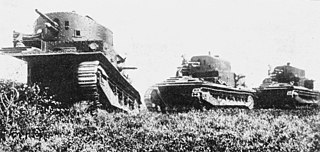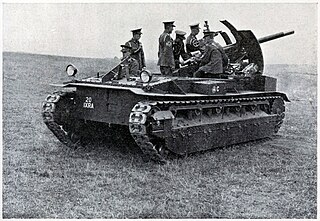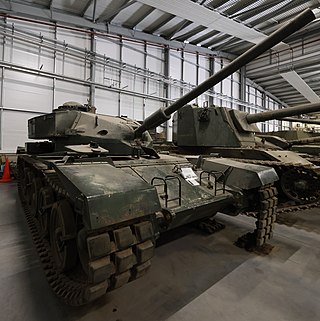
The Infantry Tank Mark II, better known as the Matilda, is a British infantry tank of the Second World War.

The Vickers 6-ton tank or Vickers Mark E, also known as the "Six-tonner", was a British light tank designed in 1928 in a private project at Vickers. Though not adopted by the British Army, it was picked up by several other armed forces, and licensed by the Soviet Union as the T-26. It was also the direct predecessor of the Polish 7TP tank.

The Tank, Infantry, Mk III, Valentine was an infantry tank produced in the United Kingdom during World War II. More than 8,000 Valentines were produced in eleven marks, plus specialised variants, accounting for about a quarter of wartime British tank production. The variants included riveted and welded construction, petrol and diesel engines and increases in armament. It was supplied in large numbers to the USSR and built under licence in Canada. It was used by the British in the North African campaign. Developed by Vickers, it proved to be strong and reliable.

The Cromwell tank, officially Tank, Cruiser, Mk VIII, Cromwell (A27M), was one of the series of cruiser tanks fielded by Britain in the Second World War. Named after the English Civil War–era military leader Oliver Cromwell, the Cromwell was the first tank put into service by the British to combine high speed from a powerful, reliable engine and reasonable armour. The intended dual-purpose high-velocity gun could not be fitted in the turret, so a medium-velocity dual-purpose gun was fitted instead. Further development of the Cromwell combined with a high-velocity gun led to the Comet tank.

The Tank, Cruiser, Mk I (A9) was a British cruiser tank of the interwar period. It was the first cruiser tank: a fast tank designed to bypass the main enemy lines and engage the enemy's lines of communication, as well as enemy tanks. The Cruiser Mk II was a more heavily armoured adaptation of the Mark I, developed at much the same time.

The cruiser tank was a British tank concept of the interwar period for tanks designed as modernised armoured and mechanised cavalry, as distinguished from infantry tanks. Cruiser tanks were developed after medium tank designs of the 1930s failed to satisfy the Royal Armoured Corps. The cruiser tank concept was conceived by Giffard Le Quesne Martel, who preferred many small light tanks to swarm an opponent, instead of a few expensive and unsatisfactory medium tanks. "Light" cruiser tanks carried less armour and were correspondingly faster, whilst "heavy" cruiser tanks had more armour and were slightly slower.

The Medium Mark A Whippet was a medium tank employed by the British in World War I. Intended for fast mobile assaults, it was intended to complement the slower British heavy tanks by using its relative mobility and speed in exploiting any break in the enemy lines.

The Medium Mark B was a British medium tank of the First World War developed as a successor to the Whippet, but ultimately unsatisfactory and production was cancelled at the end of the war.

The Medium Mark C Hornet was a British medium tank developed during the First World War, but produced too late to see any fighting.

The Tank, Infantry, Valiant (A38) was a British tank design of the Second World War that only reached the prototype stage. It was intended to meet a specification for a well-armoured, light-medium tank, for use against Japanese forces in the South-East Asia theatre. The prototype demonstrated that the design was a failure and this sole example produced was retained by the School of Tank Technology as a lesson to its students.

Horstmann suspension, also known as Horstman, Vickers-Horstman and rarely Slow Motion, is a type of tracked suspension devised by British tank designer John Carden and worked into a production design by engineer Sidney Horstmann.

Tanks were initially deployed in World War I, engineered to overcome the deadlock of trench warfare. Between the two world wars, tanks were further developed. Although they had demonstrated their battlefield effectiveness, only a few nations had the industrial resources to design and build them. During and after World War I, Britain and France pioneered tank technology, with their models generally serving as a blueprint for other countries. However, this initial advantage would slowly diminish during the 1930s, shifting in favor of the Soviet Union and, to a lesser degree, Nazi Germany.

The Vickers Medium Mark II was a British medium tank built by Vickers during the interwar period of the First and Second World Wars.

The Vickers Medium Mark I was a British tank of the Inter-war period built by Vickers from 1924.

The Birch Gun was the first practical British self-propelled artillery gun, built at the Royal Arsenal, Woolwich in 1925.

The British Mark V tank was an upgraded version of the Mark IV tank.

The Medium Mark III was a medium tank developed by the United Kingdom during the Interwar period.

This article on military tanks deals with the history and development of tanks of the British Army from their first use in the First World War, the interwar period, during the Second World War, the Cold War and modern era.
The Vickers Medium Dragon was a fully-tracked British field artillery tractor made by Vickers, produced in various versions from 1922 to 1937. The Medium Dragon towed a wide range of artillery, from 18-pounder field guns to BL 60-pounder heavy field guns. It was developed from the carrier version of a 'Tropical Tank' designed by Lt-Colonel Philip Johnson, using components from the running gear of the Vickers Medium Mark I tank.

The Tank Medium No. 2 Experimental Vehicle FV4202 also known as the 40-ton Centurion was a technology test bed developed by British company Leyland Motors between 1955 and 1956. It was used to develop various concepts later used in the Chieftain main battle tank.





















